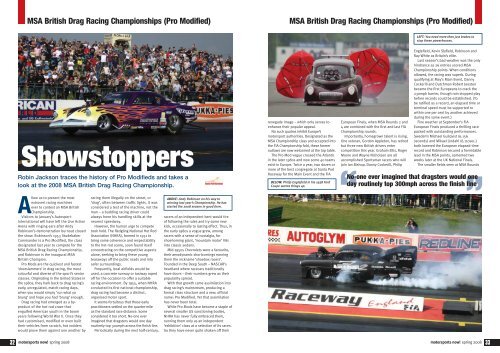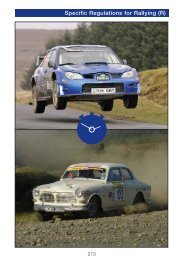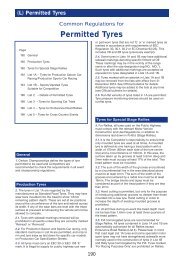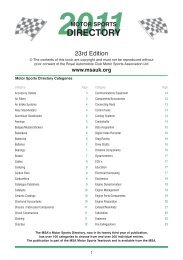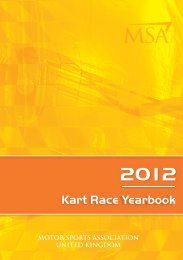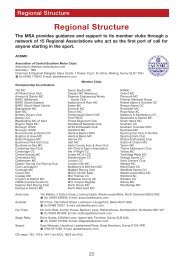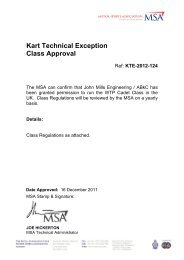MSA British Rally Elite - Motor Sports Association
MSA British Rally Elite - Motor Sports Association
MSA British Rally Elite - Motor Sports Association
Create successful ePaper yourself
Turn your PDF publications into a flip-book with our unique Google optimized e-Paper software.
32-34 drag racing_V3_NH 15/4/08 10:24 Page 32<br />
32<br />
<strong>MSA</strong> <strong>British</strong> Drag Racing Championships (Pro Modified) <strong>MSA</strong> <strong>British</strong> Drag Racing Championships (Pro Modified)<br />
Showstoppers<br />
Robin Jackson traces the history of Pro Modifieds and takes a<br />
look at the 2008 <strong>MSA</strong> <strong>British</strong> Drag Racing Championship.<br />
Allow us to present the most<br />
extrovert racing machines<br />
ever to contest an <strong>MSA</strong> <strong>British</strong><br />
Championship.<br />
Visitors to January’s Autosport-<br />
International will have left the Live Action<br />
Arena with ringing ears after Andy<br />
Robinson’s demonstration burnout closed<br />
the show. Robinson’s 1953 Studebaker<br />
Commander is a Pro Modified, the class<br />
designated last year to compete for the<br />
<strong>MSA</strong> <strong>British</strong> Drag Racing Championship,<br />
and Robinson is the inaugural <strong>MSA</strong><br />
<strong>British</strong> Champion.<br />
Pro Mods are the quickest and fastest<br />
‘doorslammers’ in drag racing, the most<br />
colourful and diverse of the sport’s senior<br />
classes. Originating in the United States in<br />
the 1980s, they hark back to drag racing’s<br />
early, unregulated, match-racing days,<br />
when you would simply ‘run what ya<br />
brung’ and hope you had ‘brung’ enough.<br />
Drag racing had emerged as a byproduct<br />
of the hot-rod craze that<br />
engulfed American youth in the boom<br />
years following World War II. Once they<br />
had customised, modified or even built<br />
their vehicles from scratch, hot rodders<br />
would prove them against one another by<br />
motorsports now! spring 2008<br />
racing them illegally on the street, or<br />
‘drag’, often between traffic lights. It was<br />
considered a test of the machine, not the<br />
man – a budding racing driver could<br />
always hone his handling skills at the<br />
nearest speedway.<br />
However, the human urge to compete<br />
took hold. The fledgling National Hot Rod<br />
<strong>Association</strong> (NHRA), formed in 1951 to<br />
bring some coherence and respectability<br />
to the hot-rod scene, soon found itself<br />
concentrating on the competitive aspects<br />
alone, seeking to bring these young<br />
tearaways off the public roads and into<br />
safer surroundings.<br />
Frequently, local airfields would be<br />
used, a concrete runway or taxiway roped<br />
off for the occasion to offer a suitable<br />
racing environment. By 1955, when NHRA<br />
conducted its first national championship,<br />
drag racing had become a distinct,<br />
organised motor sport.<br />
It seems fortuitous that those early<br />
practitioners settled on the quarter-mile<br />
as the standard race distance. Some<br />
considered it too short. No-one ever<br />
imagined that dragsters would one day<br />
routinely top 300mph across the finish line.<br />
Periodically during the next half-century,<br />
ABOVE: Andy Robinson on his way to<br />
winning last year’s Championship. He has<br />
started the 2008 season in good form.<br />
racers of an independent bent would tire<br />
of following the rules and try some new<br />
kick, occasionally to lasting effect. Thus, in<br />
the early 1980s a vogue grew, among<br />
racers with a sense of nostalgia, for<br />
shoehorning giant, ‘mountain motor’ V8s<br />
into classic sedans.<br />
Mid-1950s Chevrolets were a favourite,<br />
their aerodynamic shortcomings earning<br />
them the nickname ‘shoebox racers’.<br />
Founded in the Deep South – NASCAR’s<br />
heartland where racecars traditionally<br />
have doors – their numbers grew as their<br />
popularity spread.<br />
With that growth came assimilation into<br />
drag racing’s mainstream, producing a<br />
formal class structure and a new, official<br />
name: Pro Modified. Yet that assimilation<br />
has never been total.<br />
While Pro Mods have become a staple of<br />
several smaller US sanctioning bodies,<br />
NHRA has never fully embraced them,<br />
running them only as an independent<br />
‘exhibition’ class at a selection of its races.<br />
So they have never quite shaken off their<br />
renegade image – which only serves to<br />
enhance their popular appeal.<br />
No such qualms inhibit Europe’s<br />
motorsport authorities. Designated as the<br />
<strong>MSA</strong> Championship class and accepted into<br />
the FIA Championship fold, these former<br />
outlaws are now welcomed at the top table.<br />
The Pro Mod vogue crossed the Atlantic<br />
in the later 1980s and now some 40 teams<br />
exist in Europe. Twice a year, two dozen or<br />
more of the best congregate at Santa Pod<br />
Raceway for the Main Event and the FIA<br />
BELOW: Philip Englefield in his 1938 Ford<br />
Coupe warms things up.<br />
European Finals, when <strong>MSA</strong> Rounds 2 and<br />
4 are combined with the first and last FIA<br />
Championship rounds.<br />
Importantly, homegrown talent is rising.<br />
One veteran, Gordon Appleton, has retired<br />
but three new <strong>British</strong> drivers enter<br />
competition this year. Graham Ellis, Roger<br />
Moore and Wayne Nicholson are all<br />
accomplished <strong>Sports</strong>man racers who will<br />
join Ian Bishop, Danny Cockerill, Philip<br />
LEFT: You need more than just brakes to<br />
stop these powerhouses.<br />
Englefield, Kevin Slyfield, Robinson and<br />
Ray White as Britain’s elite.<br />
Last season’s bad weather was the only<br />
hindrance as 26 entries scored <strong>MSA</strong><br />
Championship points. When conditions<br />
allowed, the racing was superb. During<br />
qualifying at May’s Main Event, Danny<br />
Cockerill and Dutchman Robert Joosten<br />
became the first Europeans to crack the<br />
230mph barrier, though rain stopped play<br />
before records could be established. (To<br />
be ratified as a record, an elapsed time or<br />
terminal speed must be supported to<br />
within one per cent by another achieved<br />
during the same event.)<br />
Fine weather at September’s FIA<br />
European Finals produced a thrilling race<br />
packed with outstanding performances.<br />
Sweden’s Michael Gullqvist (6.156<br />
seconds) and Mikael Lindahl (6.110sec.)<br />
both lowered the European elapsed-time<br />
record and Robinson secured a formidable<br />
lead in the <strong>MSA</strong> points, cemented two<br />
weeks later at the UK National Finals.<br />
The smaller fields seen at <strong>MSA</strong> Rounds<br />
No-one ever imagined that dragsters would one<br />
day routinely top 300mph across the finish line<br />
motorsports now! spring 2008<br />
33


